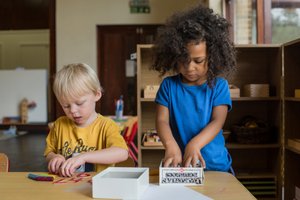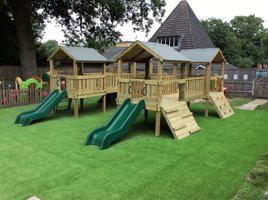Dulwich Oaks Montessori
Nursery School
Call the Nursery:
020 8761 6555
Visit us: 22 Dulwich Wood Park, Dulwich, London, SE19 1HL
ACCEPTING CHILDREN FROM 12 MONTHS TO 5 YEARS
THE MONTESSORI METHOD
"The first essential for a child's development is concentration. They must find out how to concentrate and for this they need things to concentrate upon."
Maria Montessori, "The Montessori Method"
The Montessori Method was developed by Dr. Maria Montessori (1870- 1952) who was the first woman to receive a medical degree in Italy in 1894. She believed that a child will learn naturally in an environment consisting of 'learning games' suited to the child's abilities and interests. She developed a range of apparatus to utilise and refine the child’s fine and gross motor skills using the five senses.
The apparatus consists of ‘Practical Life’, ‘Sensorial’, Language, Mathematics and ‘Cultural Subjects’.
The ‘Practical Life’ section includes many items the child is used to seeing in the home and by using jugs, tongs, cups and everyday objects, the children begin practising their pencil grip, start to build up their concentration and refine their hand-to-eye co-ordination. In this section the child also learns to tie bows, fasten buttons etc enabling them to dress themselves and slowly gain more independence. This area aids the child’s development in caring for people and the environment, controlling his/her movements, and forming social relationships.
Practical Life is the foundation for any kind of academics as it provides a sense of order, concentration, co-ordination and independence. It also fosters care of the environment and care of oneself.
The ‘Sensorial’ section includes many specially designed items that utilize the five senses e.g. The colour tablets, sound boxes, smell jars and touch tablets. The Sensorial materials help the children refine their senses and power of observation. The development readiness for greater intellectual work. The materials are designed to develop and train the delicate senses of touch, smell, taste, sound and visual perception. By stimulating the child’s senses and encouraging them to concentrate, the use of the ‘Sensorial’ apparatus lays good foundations for their later language and mathematics work.
Reading and writing skills are taught primarily using phonetics through a wide variety of materials that the children find interesting and fun. Once confident of their letter sounds, they are encouraged to build words for themselves and later break them down in order to read them. The language training provides the children with the understanding that separate sounds can be blended together to form words. Learning to read incorporates movement like tracing of sandpaper letters or forming words with the movable alphabet.
At first, children receive individual support in learning letter sounds and directions. Montessori recognized the now widely accepted principle that synthetic phonics is the best method for developing early literacy.
By indirectly introducing basic number skills and mathematical theories in the ‘Sensorial’ apparatus, the child is then ready to begin using the various materials designed to teach number names, quantities and later, addition, subtraction, multiplication and division.
The ‘Cultural’ section includes science, nature, history and biology. These subjects are dealt with initially relating to the child’s immediate environment, later encompassing a much wider concept. Jigsaw maps, globes and classification cards are used to introduce the child to a wealth of information and encourage them to investigate the world about them.
“Help me to help myself”
Maria Montessori


